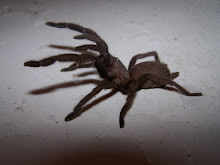Environmentally Friendly Pest Control: An Overview of The Sterile Insect Technique
In many cases, we can use the insects themselves to aid us in their elimination. One method, called the Sterile Insect Technique (SIT) involves using sterilized insects to drive the population down.
First, insects are raised in rearing facilities to adulthood. Then, males are singled out with a variety of methods (which I won't go into here...feel free to dig up the sources via google scholar), sterilized and released into the field in droves. This is preferable to pesticides because the technique is generally very environmentally friendly and species specific-no chance innocent bugs getting caught in the crossfire or people accidentally being exposed to pesticide.
This technique has been used with great success against the tsetse fly of Africa and on the screw-worms of North America. The tsetse flies (Glossnia ssp.) are best known for transmitting trypanosomaisis, or sleeping sickness as it's commonly known. It's a horrible disease, and some of the treatments are fatal about 10% of the time. The disease is usually fatal in most people who remain untreated. Fortunately, we can control it's vector. If we control it's vector, it can't pass from person to person. If it can't pass from person to person, the disease dies out. Screwworms aren't disease vectors for humans...and don't really affect us but their effects on cattle are even more horrifying. Adults are attracted to open wounds, where they lay their eggs. The larvae hatch, start eating the living flesh, and the scents released while they feed attract more female screwworm flies. At the very least, the cattle lose value and lose weight. Infestations resulting in death weren't uncommon before the measures were taken to eradicate the pest.
In controlling trypanosomiasis and screwworm flies, scientists use radiation (usually Cobalt-60, but also X-rays) to sterilize male flies and release them on the wild population so they mate with females. Many insects mate only once, and this would cause the female to lay infertile eggs or in the case of tsetse flies whose larvae develop internally, expel dead larvae. This causes a drop in the population of the target insect species, and the process is repeated for the next generation. Sooner or later, the number of sterile males outnumber the wild-type fertile males and eventually the population goes extinct.
Unfortunately, there are some drawbacks to this procedure. For example, one has to know that there will not be much migration into an area. If outside females who have already mated can immigrate into an area on a regular basis and reproduce, this tactic only becomes good for suppression. One of the biggest drawbacks is the fact that it's simply not economical. It has to have backing from a wealthy country like the US or United Nations in many cases and it is very labor intensive. This technique has been used for some agricultural pests (pink bollworm and the Mediterranian fruit fly to name a few), but would be ineffective for parthenogenic sawflies and aphids because they do not rely on males to reproduce. So it's not a silver bullet...but for many species which reproduce sexually, it's definitely effective. Many areas of Africa are now free of tsetse flies because of this technique, and the US hasn't seen an infestation since 1966
Many times, the flies are sexed manually when pupae by trained professionals. Other times, insects may be genetically modified with a gene coding for insecticide resistance on the Y chromosome. After this, they need to be carted into packages, refrigerated and dispersed around the habitat...sometimes by air. Of course, the biggest problem is when the equipment breaks down. In one case, a facility using the SIT had it's irradiation equipment fail and accidentally released millions of fertile male screwworms into the environment. These types of mistakes would simply set the project back awhile, but not render it ineffective.
This technique creates a lot of waste in terms of insects. Only about half the insects produced by any given facility can be used for two reasons. One reason is that in many cases, it's the female and only the female who can transmit disease. A female with non-working reproductive parts can and will take blood meals, which means they can still be disease vectors. The second reason is that mixed releases are simply inneffective. The goal is to get the males to spread throughout the area. Unfortunately, male insects have the 'dude in a nightclub' mentality-they won't spread out if they're released with females.
Why go prowling if you can get laid right at home? I've stayed in many a crappy nightclub for no other reason than because I was having success with the women there...and the same principle applies here.
http://www.ars.usda.gov/is/pr/2002/020828.htm
Alphey, L. (2002). Re-engineering the sterile insect technique. Insect Biochemistry and Molecular Biology, 32(10), 1243-1247. DOI: 10.1016/S0965-1748(02)00087-5
Pedigo, Larry P., Rice, Marlin E. (2009). Entomology and Pest Management (6th ed). New Jersey: Pearson Education
Vreysen, M.B., Saleh, K.M., Ali, M.Y., Abdulla, A., Zhu, Z., Juma, K.G., Dyck, A., Atway, M.R., Mkonyi, P.A., , . (2000). Glossnia austeni (Diptera: Glossinidae) Eridicated on the Island of Unguja, Zanzibar Using the Sterile Insect Technique. Journal of Economic Entomology, 93(1), 123-135.
Labels: Entomology, Medical blogging, Peer-reviewed research


0 Comments:
Post a Comment
Subscribe to Post Comments [Atom]
<< Home